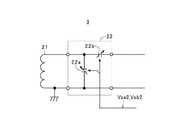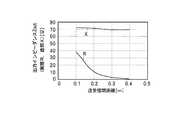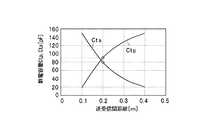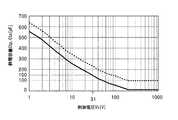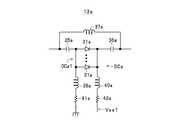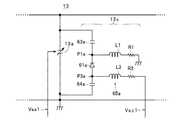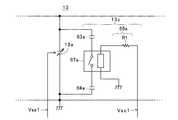JP2013051864A - Transmission device and non-contact power transmission system - Google Patents
Transmission device and non-contact power transmission systemDownload PDFInfo
- Publication number
- JP2013051864A JP2013051864AJP2011228644AJP2011228644AJP2013051864AJP 2013051864 AJP2013051864 AJP 2013051864AJP 2011228644 AJP2011228644 AJP 2011228644AJP 2011228644 AJP2011228644 AJP 2011228644AJP 2013051864 AJP2013051864 AJP 2013051864A
- Authority
- JP
- Japan
- Prior art keywords
- circuit
- diode
- power transmission
- power
- capacitance
- Prior art date
- Legal status (The legal status is an assumption and is not a legal conclusion. Google has not performed a legal analysis and makes no representation as to the accuracy of the status listed.)
- Granted
Links
Images
Landscapes
- Charge And Discharge Circuits For Batteries Or The Like (AREA)
Abstract
Description
Translated fromJapanese本発明は、磁気共鳴を利用して受電装置へ電力を伝送する送電装置、およびこの送電装置および受電装置を有する非接触型電力伝送システムに関するものである。 The present invention relates to a power transmission device that transmits power to a power receiving device using magnetic resonance, and a contactless power transmission system including the power transmission device and the power receiving device.
この種の非接触型電力伝送システムとして、本願出願人は、下記特許文献1に開示された非接触型電力伝送システムを既に提案している。この非接触型電力伝送システムは、交流信号を発生する信号発生部、および交流信号の供給を受けて電磁場を発生させる送信アンテナを有する送電装置と、電磁場によって誘導電圧を発生する受信アンテナ、および誘導電圧に基づいて負荷に供給する電圧を生成する電圧生成部を有する受電装置とを備えた非接触型電力伝送システムであって、送電装置には、信号発生部と送信アンテナとの間に可変コンデンサで構成された第1整合部が配設され、受電装置には、受信アンテナと電圧生成部との間に可変コンデンサで構成された第2整合部が配設されている。また、第1整合部を制御して信号発生部と送信アンテナとを整合させる第1処理を実行する第1処理部を備えると共に、第2整合部を制御して受信アンテナと電圧生成部とを整合させる第2処理とを実行する第2処理部を備えている。 As this type of contactless power transmission system, the present applicant has already proposed a contactless power transmission system disclosed in
この非接触型電力伝送システムでは、第1処理部が、受電装置の存在を検出したときに、第1整合部の可変コンデンサの静電容量値を制御して信号発生部と送信アンテナとを整合状態に移行させると共に、第1処理部が、第2整合部の可変コンデンサの静電容量値を制御して受信アンテナと電圧生成部とを整合状態に移行させる。したがって、この電力伝送システムによれば、送電装置に対して受電装置が様々な距離に配置されたとしても、送電装置だけでなく、受電装置についても、常に送電装置および受電装置間の距離の長短に応じた整合状態に移行させることができ、この結果、電力伝送を伝送効率の良い状態で行うことができる。このため、この電力伝送システムによれば、電力の伝送効率の低下を最小限に抑えつつ、良好に電力伝送できる送電装置と受電装置との間の距離の範囲を拡げることが可能となっている。 In this non-contact power transmission system, when the first processing unit detects the presence of the power receiving device, the capacitance value of the variable capacitor of the first matching unit is controlled to match the signal generating unit and the transmitting antenna. At the same time, the first processing unit controls the capacitance value of the variable capacitor of the second matching unit to shift the receiving antenna and the voltage generation unit to the matching state. Therefore, according to this power transmission system, even if the power receiving device is arranged at various distances with respect to the power transmitting device, not only the power transmitting device but also the power receiving device always has a short and long distance between the power transmitting device and the power receiving device. As a result, power transmission can be performed with good transmission efficiency. For this reason, according to this power transmission system, it is possible to expand the range of the distance between the power transmitting device and the power receiving device that can satisfactorily transmit power while minimizing a decrease in power transmission efficiency. .
ところで、上記の非接触型電力伝送システムにおいて送電装置から受電装置に対して数十ワット程度の電力(中電力)を伝送する場合には、送電装置などの整合部において使用される可変コンデンサとして、例えば下記特許文献2に開示されているような可変コンデンサが一般的に使用される。この可変コンデンサは、複数の固定翼と、固定翼の各対の間に散在して配設された容量性調整要素(回転翼)を備え、各回転翼が取り付けられたシャフトをモータで回転させて、固定翼の上に重なる各回転翼の面積を増減することにより、静電容量値を変化させることが可能となっている。 By the way, in the case of transmitting power of about several tens of watts (medium power) from the power transmitting device to the power receiving device in the above contactless power transmission system, as a variable capacitor used in a matching unit such as a power transmitting device, For example, a variable capacitor as disclosed in
ところが、上記した可変コンデンサで整合部を構成した非接触型電力伝送システムには、以下の解決すべき課題が存在している。すなわち、この非接触型電力伝送システムでは、モータによって機械的に構成要素(各回転翼が取り付けられたシャフト)を動かして可変コンデンサの静電容量値を変更させる構成のため、送電装置においては、信号発生部と送信アンテナとを整合させるまでに要する時間(整合状態に移行させるまでの時間)が長くなるという解決すべき課題が存在している。このため、例えば、送電装置と受電装置とが電力伝送の可能な範囲内で相対的に移動する電力伝送システムのように、整合スピードが要求されるシステムには対応できないという解決すべき課題が存在している。また、上記のような機械的構成(各回転翼が取り付けられたシャフト)を動かして静電容量値を変更する可変コンデンサおよびこの可変コンデンサを駆動するモータはそれぞれ外形が大きいため、これらを備えた整合部、ひいては送電装置、さらにはこの送電装置を有する非接触型電力伝送システムが大型化するという解決すべき課題も存在している。 However, the following problems to be solved exist in the non-contact power transmission system in which the matching unit is configured by the variable capacitor described above. That is, in this non-contact type power transmission system, the power transmission device is configured to change the capacitance value of the variable capacitor by mechanically moving a component (a shaft on which each rotor blade is attached) by a motor. There is a problem to be solved that the time required to match the signal generation unit and the transmission antenna (the time required to shift to the matching state) becomes long. For this reason, for example, there is a problem to be solved that cannot be applied to a system that requires matching speed, such as a power transmission system in which a power transmission device and a power reception device move relatively within a range where power transmission is possible. doing. In addition, a variable capacitor that changes the capacitance value by moving the mechanical configuration as described above (the shaft to which each rotor blade is attached) and a motor that drives the variable capacitor have large outer shapes, and thus are provided. There is also a problem to be solved that the matching unit, by extension, the power transmission device, and further the contactless power transmission system having this power transmission device is increased in size.
本発明は、かかる課題を解決すべくなされたものであり、大型化を回避しつつ短時間で整合状態に移行させ得る送電装置、およびこの送電装置を備えた非接触型電力伝送システムを提供することを主目的とする。 The present invention has been made to solve such a problem, and provides a power transmission device capable of shifting to a matching state in a short time while avoiding an increase in size, and a contactless power transmission system including the power transmission device. The main purpose.
上記目的を達成すべく請求項1記載の送電装置は、交流信号を発生する信号発生部、前記交流信号の供給を受けて電磁場を発生させる送信アンテナ、および前記信号発生部と前記送信アンテナとの間に配設された整合部を有し、前記電磁場によって誘導電圧を発生する受信アンテナおよび当該誘導電圧に基づいて負荷に供給する電圧を生成する電圧生成部を有する受電装置に送電する送電装置であって、前記整合部は、アノード端子を基準としてカソード端子に印加される逆バイアス電圧に応じて静電容量値を変化させる可変容量ダイオードで構成されたダイオード回路を有する可変コンデンサ回路を備えて構成され、前記逆バイアス電圧を制御して前記可変コンデンサ回路の静電容量値を変化させることにより、前記信号発生部と前記送信アンテナとを整合させる整合処理を実行する処理部を備えている。 In order to achieve the above object, a power transmission device according to
また、請求項2記載の送電装置は、請求項1記載の送電装置において、前記ダイオード回路に対して並列に接続されたインダクタを備えている。 According to a second aspect of the present invention, in the power transmission device according to the first aspect, the power transmission device includes an inductor connected in parallel to the diode circuit.
また、請求項3記載の送電装置は、請求項1または2記載の送電装置において、前記ダイオード回路は、1または互いに順方向で並列接続された複数の前記可変容量ダイオードで構成される第1副ダイオード回路と、1または互いに順方向で並列接続された複数の前記可変容量ダイオードで構成されると共に前記第1副ダイオード回路と対向して直列接続された第2副ダイオード回路とを有し、前記逆バイアス電圧が前記第1副ダイオード回路および前記第2副ダイオード回路のそれぞれに印加される。 The power transmission device according to
また、請求項4記載の送電装置は、請求項1または2記載の送電装置において、前記ダイオード回路は、互いに順方向で並列接続された複数の前記可変容量ダイオードで構成されている。 According to a fourth aspect of the present invention, in the power transmission device according to the first or second aspect, the diode circuit includes a plurality of the variable capacitance diodes connected in parallel in the forward direction.
また、請求項5記載の送電装置は、請求項1または2記載の送電装置において、前記ダイオード回路は、1または互いに順方向で並列接続された複数の前記可変容量ダイオードで構成される第3副ダイオード回路と、1または互いに順方向で並列接続された複数の前記可変容量ダイオードで構成されると共に前記第3副ダイオード回路と順方向で直列接続された第4副ダイオード回路とを有し、前記逆バイアス電圧が前記第3副ダイオード回路および前記第4副ダイオード回路のそれぞれに印加される。 The power transmission device according to claim 5 is the power transmission device according to
また、請求項6記載の送電装置は、請求項1から5のいずれかに記載の送電装置において、前記信号発生部と前記整合部との間に配設されて、進行波電力値と反射波電力値とを測定する電力測定部を備え、前記信号発生部は、前記交流信号の出力電力値を制御可能に構成され、前記処理部は、前記信号発生部と前記送信アンテナとを整合させた状態において、前記進行波電力値、前記反射波電力値、前記逆バイアス電圧から算出される前記可変コンデンサ回路の静電容量値、および予め測定された前記受電装置との間の送受信間距離と前記整合部の出力インピーダンスとの関係に基づいて前記送受信間距離を算出しつつ、当該算出している送受信間距離が前記信号発生部と前記送信アンテナとを整合可能な範囲を外れると判別したときには、前記信号発生部に対して前記交流信号の発生を停止させる。 A power transmission device according to a sixth aspect is the power transmission device according to any one of the first to fifth aspects, wherein the power transmission device is disposed between the signal generation unit and the matching unit, so that a traveling wave power value and a reflected wave are disposed. A power measurement unit that measures a power value, wherein the signal generation unit is configured to control an output power value of the AC signal, and the processing unit matches the signal generation unit and the transmission antenna. In the state, the traveling wave power value, the reflected wave power value, the capacitance value of the variable capacitor circuit calculated from the reverse bias voltage, and the distance between transmission and reception between the power receiving device measured in advance and the While calculating the inter-transmission / reception distance based on the relationship with the output impedance of the matching unit, when determining that the calculated inter-transmission / reception distance is outside the range in which the signal generation unit and the transmission antenna can be matched, Stopping generation of the AC signal to the serial signal generator.
また、請求項7記載の送電装置は、請求項1から6のいずれかに記載の送電装置において、前記可変容量ダイオードに印加されている印加電圧を検出する検出部を備え、前記信号発生部は、前記交流信号の出力電力値を制御可能に構成され、前記処理部は、前記検出された印加電圧と前記逆バイアス電圧とを比較して、当該検出された印加電圧が当該逆バイアス電圧に達しないときには、前記信号発生部に対して前記交流信号の発生を停止させる。 A power transmission device according to claim 7 is the power transmission device according to any one of
また、請求項8記載の送電装置は、請求項1から7のいずれかに記載の送電装置において、前記整合部は、固定コンデンサ、および当該固定コンデンサの前記可変コンデンサ回路への並列接続および非並列接続を切り替える切替素子を有する容量付加回路を備えている。 The power transmission device according to claim 8 is the power transmission device according to any one of
また、請求項9記載の非接触型電力伝送システムは、請求項1から8のいずれかに記載の送電装置と前記受電装置とを備えている。 A non-contact power transmission system according to a ninth aspect includes the power transmission device according to any one of the first to eighth aspects and the power reception device.
請求項1記載の送電装置および請求項9記載の非接触型電力伝送システムでは、アノード端子を基準としてカソード端子に印加される逆バイアス電圧に応じて静電容量値を変化させる可変容量ダイオードで構成されたダイオード回路を有する可変コンデンサ回路を備えて整合部が構成されている。 The power transmission device according to
したがって、この送電装置および電力伝送システムによれば、逆バイアス電圧の変更により、整合部の可変コンデンサ回路の静電容量値を瞬時に変化させる(変更する)ことができることから、信号発生部と送信アンテナとを極めて短時間で整合させることができる。これにより、送電装置と受電装置との間の距離(送受信間距離)がリアルタイムに変化したとしても、信号発生部と送信アンテナとの整合状態を良好に維持することができるため、受電装置に対する電力伝送を効率の良い状態で継続することができる。また、可変容量ダイオードを使用して可変コンデンサ回路を構成したことにより、送電装置を小型化することができる。 Therefore, according to the power transmission device and the power transmission system, the capacitance value of the variable capacitor circuit of the matching unit can be instantaneously changed (changed) by changing the reverse bias voltage. The antenna can be matched in an extremely short time. As a result, even if the distance between the power transmission device and the power reception device (distance between transmission and reception) changes in real time, the matching state between the signal generation unit and the transmission antenna can be satisfactorily maintained. Transmission can be continued in an efficient state. In addition, since the variable capacitor circuit is configured using the variable capacitance diode, the power transmission device can be reduced in size.
請求項2記載の送電装置および請求項9記載の非接触型電力伝送システムでは、ダイオード回路に対して並列に接続されたインダクタを備えているため、可変コンデンサ回路の静電容量値についての容量変更範囲の下限値が引き下げられている。したがって、この送電装置およびこの電力伝送システムによれば、送電装置と受電装置との距離(送受信間距離)が短い状態においても、信号発生部と送信アンテナとを整合させて、受電装置に対する電力伝送を効率の良い状態で実行することができる。 Since the power transmission device according to
請求項3記載の送電装置および請求項9記載の非接触型電力伝送システムでは、第1副ダイオード回路と、第1副ダイオード回路と対向して直列接続された第2副ダイオード回路とを有し、逆バイアス電圧が各副ダイオード回路のそれぞれに印加される。 The power transmission device according to
したがって、この送電装置およびこの電力伝送システムによれば、可変コンデンサ回路において、第1副ダイオード回路を構成する可変容量ダイオードおよび第2副ダイオード回路を構成する可変容量ダイオードに、交流信号を1/2に分圧して印加することができる。このため、交流信号の電力を一定(交流信号の振幅を一定)とした場合において、可変容量ダイオードを直列接続しない構成と比較して、可変容量ダイオードを逆バイアスの状態に維持できる逆バイアス電圧の下限値を低くすることができ、これによって可変コンデンサ回路の静電容量値についての容量変更範囲の上限値を高めることができる。すなわち、整合状態で受電装置に対して送電できる送受信間距離の範囲を拡げることができる。 Therefore, according to the power transmission device and the power transmission system, in the variable capacitor circuit, an AC signal is halved to the variable capacitance diode constituting the first sub-diode circuit and the variable capacitance diode constituting the second sub-diode circuit. It is possible to apply the pressure by dividing the pressure. For this reason, when the power of the AC signal is constant (the amplitude of the AC signal is constant), the reverse bias voltage can be maintained in the reverse bias state as compared with the configuration in which the variable capacitor diodes are not connected in series. The lower limit value can be lowered, and thereby the upper limit value of the capacitance change range for the capacitance value of the variable capacitor circuit can be increased. That is, the range of the distance between transmission and reception that can transmit power to the power receiving apparatus in the aligned state can be expanded.
請求項4記載の送電装置および請求項9記載の非接触型電力伝送システムによれば、互いに順方向で並列接続された複数の可変容量ダイオードでダイオード回路を構成したことにより、各副ダイオード回路を、1つの可変容量ダイオードで構成する構成と比較して、可変コンデンサ回路の各静電容量値についての容量変更範囲の上限値を高めることができる。すなわち、整合状態で受電装置に対して送電できる送受信間距離の範囲を拡げることができる。 According to the power transmission device according to
請求項5記載の送電装置および請求項9記載の非接触型電力伝送システムでは、ダイオード回路を、1または互いに順方向で並列接続された複数の可変容量ダイオードで構成される第3副ダイオード回路と、1または互いに順方向で並列接続された複数の可変容量ダイオードで構成されると共に第3副ダイオード回路と順方向で直列接続された第4副ダイオード回路とを有し、逆バイアス電圧が第3副ダイオード回路および第4副ダイオード回路のそれぞれに印加される。 The power transmission device according to claim 5 and the non-contact power transmission system according to claim 9, wherein the diode circuit is one or a third sub-diode circuit composed of a plurality of variable capacitance diodes connected in parallel to each other in the forward direction. 1 or a plurality of variable capacitance diodes connected in parallel in the forward direction and having a third sub-diode circuit and a fourth sub-diode circuit connected in series in the forward direction. Applied to each of the sub-diode circuit and the fourth sub-diode circuit.
したがって、この送電装置およびこの電力伝送システムによれば、第3副ダイオード回路を構成する可変容量ダイオードおよび第4副ダイオード回路を構成する可変容量ダイオードに、交流信号を1/2に分圧して印加することができると共に、可変コンデンサ回路全体の静電容量値についての容量変更範囲を拡げることができる。 Therefore, according to this power transmission device and this power transmission system, an AC signal is divided and applied to the variable capacitance diodes constituting the third sub-diode circuit and the variable capacitance diodes constituting the fourth sub-diode circuit. In addition, the capacitance changing range for the capacitance value of the entire variable capacitor circuit can be expanded.
請求項6記載の送電装置および請求項9記載の非接触型電力伝送システムによれば、送電装置と受電装置との距離(送受信間距離)が整合可能な範囲から外れて、信号発生部と送信アンテナとを整合状態に移行させることができない状態に至ったとしても、信号発生部からの交流信号の発生が停止されるため、交流信号の発生を継続させた場合に発生する虞のある大きな反射波電力に起因した第1整合部の各構成要素への過大な電圧の連続した印加を確実に防止することができる。 According to the power transmission device according to claim 6 and the contactless power transmission system according to claim 9, the distance between the power transmission device and the power reception device (distance between transmission and reception) is out of a range where matching is possible, and the signal generator and the transmission Even if the antenna cannot be moved to the matching state, the generation of the AC signal from the signal generation unit is stopped, so that a large reflection that may occur when the generation of the AC signal is continued. Continuous application of an excessive voltage to each component of the first matching unit due to wave power can be reliably prevented.
請求項7記載の送電装置および請求項9記載の非接触型電力伝送システムでは、処理部が、検出部によって検出された印加電圧と逆バイアス電圧とを比較して、印加電圧が逆バイアス電圧に達しないときには、交流信号を停止させる。 In the power transmission device according to claim 7 and the non-contact power transmission system according to claim 9, the processing unit compares the applied voltage detected by the detection unit with the reverse bias voltage, and the applied voltage becomes the reverse bias voltage. If not, the AC signal is stopped.
したがって、この送電装置およびこの電力伝送システムによれば、交流信号の電力の増加に起因して可変容量ダイオードの逆バイアス状態が維持されない状況に至ったとき、すなわち、可変容量ダイオードとして機能しない状態に至って信号発生部と送信アンテナとを整合状態に移行させることができない状態になったときには、交流信号が停止されるため、交流信号の発生を継続させた場合に発生する虞のある大きな反射波電力に起因した第1整合部の各構成要素への過大な電圧の連続した印加を確実に防止することができる。 Therefore, according to the power transmission device and the power transmission system, when the reverse bias state of the variable capacitance diode is not maintained due to the increase in the power of the AC signal, that is, the variable capacitance diode does not function. Since the AC signal is stopped when the signal generator and the transmitting antenna cannot be shifted to the matching state, the large reflected wave power that may be generated when the generation of the AC signal is continued. It is possible to reliably prevent the continuous application of an excessive voltage to each component of the first matching unit due to the above.
請求項8記載の送電装置および請求項9記載の非接触型電力伝送システムによれば、整合部は、固定コンデンサ、および固定コンデンサの可変コンデンサ回路への並列接続および非並列接続を切り替える切替素子を有する容量付加回路を備えているため、可変コンデンサ回路および容量付加回路の全体としての静電容量値を、可変コンデンサ回路単体の容量可変範囲内で変化させることができると共に、可変コンデンサ回路単体の容量可変範囲の下限値に固定コンデンサの静電容量値を加えた静電容量値を下限値とし、かつ可変コンデンサ回路単体の容量可変範囲の上限値に固定コンデンサの静電容量値を加えた静電容量値を上限値とする別の容量可変範囲内でも変化させることができるため、可変コンデンサ回路だけの構成と比較して、容量可変範囲を拡げることができる。したがって、この送電装置および非接触型電力伝送システムによれば、信号発生部と送信アンテナとの整合状態を良好に維持させて、受電装置に対して効率の良い状態で電力伝送し得る範囲(送電装置と受電装置との間の距離)を拡げることができる。 According to the power transmission device according to claim 8 and the contactless power transmission system according to claim 9, the matching unit includes a fixed capacitor and a switching element that switches between parallel connection and non-parallel connection of the fixed capacitor to the variable capacitor circuit. Since the capacitance adding circuit having the variable capacitor circuit and the capacitance adding circuit as a whole can be changed within the variable capacitance range of the variable capacitor circuit alone, the capacitance of the variable capacitor circuit alone can be changed. The electrostatic capacitance value obtained by adding the capacitance value of the fixed capacitor to the lower limit value of the variable range as the lower limit value, and adding the capacitance value of the fixed capacitor to the upper limit value of the capacitance variable range of the variable capacitor circuit alone Since it can be changed within another capacitance variable range with the capacitance value as the upper limit value, it can be compared with a configuration with only a variable capacitor circuit. Variable range can be expanded. Therefore, according to the power transmission device and the non-contact power transmission system, a range in which power can be efficiently transmitted to the power receiving device while maintaining a good matching state between the signal generation unit and the transmission antenna (power transmission) The distance between the device and the power receiving device can be increased.
以下、添付図面を参照して、送電装置および非接触型電力伝送システムの実施の形態について説明する。 Hereinafter, embodiments of a power transmission device and a contactless power transmission system will be described with reference to the accompanying drawings.
図1に示す非接触型電力伝送システム(以下、単に「電力伝送システム」ともいう)1は、一例として送電装置2および受電装置3を備えて構成され、送電装置2が受電装置3に対して非接触で電力を伝送し、受電装置3が送電装置2から受電した電力を負荷(本例では、一例としてバッテリ)4に対して出力する。 A contactless power transmission system (hereinafter also simply referred to as “power transmission system”) 1 illustrated in FIG. 1 includes a
送電装置2は、信号発生部11、送信アンテナ12、第1整合部13、電力計測部14および第1処理部15を備えて構成されている。信号発生部11は、交流信号S1(本例では一例として、周波数f(数MHzから数十MHz。一例として、13.56MHz)の交流信号を発生して出力する。また、信号発生部11は、第1処理部15によって制御されて、交流信号S1の出力電力値を変更可能に構成されている。 The
送信アンテナ12は、一例としてコイル形状(つるまきバネ形状や平面コイル形状)に形成されている。また、送信アンテナ12は、交流信号S1の供給を受けて電磁場を発生させて、受電装置3に配設された後述の受信アンテナ21と電磁結合する。 As an example, the
第1整合部(整合部)13は、信号発生部11と送信アンテナ12との間に配設されて(具体的には、信号発生部11と送信アンテナ12とを接続する伝送路に介装されて)、受信アンテナ21との間の距離に応じて変化する送信アンテナ12のインピーダンス(入力インピーダンス)に信号発生部11側のインピーダンスを整合させる(信号発生部11と送信アンテナ12とを整合状態に移行させる)。 The first matching unit (matching unit) 13 is disposed between the
本例では、一例として、第1整合部13は、図3に示すように、送信アンテナ12に対して並列に接続された可変コンデンサ回路13aと、送信アンテナ12に対して直列(具体的には、送信アンテナ12および可変コンデンサ回路13aからなる並列回路に対して直列)に接続された可変コンデンサ回路13bとを備えて構成されている。また、第1整合部13は、可変コンデンサ回路13a,13bの各静電容量値が第1処理部15から出力される制御電圧Vsa1,Vsb1(逆バイアス電圧である直流電圧)によって別個独立して制御されることにより、送信アンテナ12(詳しくは、信号発生部11側から見た送信アンテナ12の入力インピーダンス)と信号発生部11(詳しくは、送信アンテナ12側から見た信号発生部11側の出力インピーダンス)とを整合可能となっている。 In this example, as an example, as shown in FIG. 3, the
具体的には、可変コンデンサ回路13aは、図5に示すように、ダイオード回路DCa、小型電子部品である2つのコンデンサ35a,36a、小型電子部品である1つのインダクタ37a、小型電子部品である3つのインダクタ38a,39a,40a、および小型電子部品である3つの抵抗41a,42a,43aを備えている。この場合、ダイオード回路DCaは、小型電子部品である可変容量ダイオードとしてのダイオード31aで構成された第1副ダイオード回路DCa1、および小型電子部品である可変容量ダイオードとしてのダイオード32aで構成された第2副ダイオード回路DCa2を備えている。第1副ダイオード回路DCa1は、1つのダイオード31a、または互いに順方向で並列接続(カソード端子同士が接続されると共にアノード端子同士が接続)された複数のダイオード31aで構成されている。第2副ダイオード回路DCa2は、1つのダイオード32a、または互いに順方向で並列接続された複数のダイオード32aで構成されている。また、このようにして構成された第1副ダイオード回路DCa1および第2副ダイオード回路DCa2は、対向して直列接続(カソード端子同士が接続されるか、またはアノード端子同士が接続。本例では、カソード端子同士が接続)されている。ダイオード31aおよびダイオード32a、並びに後述するダイオード31bおよびダイオード32bとしては、ショットキーバリアダイオードやファーストリカバリーダイオードが使用される。 Specifically, as shown in FIG. 5, the
コンデンサ35aは、一端がダイオード回路DCaの一端(各ダイオード31aのアノード端子)に接続されると共に、他端が可変コンデンサ回路13aの一端として、可変コンデンサ回路13bおよび送信アンテナ12に接続されている。コンデンサ36aは、一端がダイオード回路DCaの他端(各ダイオード32aのアノード端子)に接続されると共に、他端が可変コンデンサ回路13aの他端として、送電装置2の基準電位(本例では一例としてグランド電位)に接続されている。この構成により、2つのコンデンサ35a,36aは、ダイオード回路DCaに対してそれぞれ直列に接続されている。 One end of the
また、各コンデンサ35a,36aは、可変コンデンサ回路13aのダイオード回路DCaに印加される制御電圧Vsa1が可変コンデンサ回路13aの外部に漏洩する事態を防止するための直流カット用コンデンサであり、交流信号S1の周波数fにおけるインピーダンスが、ダイオード回路DCaのインピーダンスに対して十分に小さくなる静電容量値に規定されている(一例として、ダイオード回路DCaの合成容量値の2倍以上の静電容量値に規定されている)。 The
インダクタ37aは、一端がコンデンサ35aの他端に接続されると共に、他端がコンデンサ36aの他端に接続されている。この構成により、インダクタ37aは、ダイオード回路DCaに対して並列に、具体的には、コンデンサ35a,36aおよびダイオード回路DCaの直列回路に対して並列に並列インダクタとして接続されている。このインダクタ37aは、後述するように、制御電圧Vsa1によって変化させられる可変コンデンサ回路13aの静電容量値Ctp1についての容量変更範囲の下限値を引き下げる機能を有している。 The
インダクタ38aおよび抵抗41aは、互いに直列に接続されて、ダイオード回路DCaの一端と基準電位との間に配設されている。インダクタ39aおよび抵抗42aは、互いに直列に接続されて、ダイオード回路DCaの他端と基準電位との間に配設されている。インダクタ40aおよび抵抗43aは、互いに直列に接続されて、これらの直列回路の一端(本例では一例としてインダクタ40a側の端部)が、ダイオード回路DCaにおける第1副ダイオード回路DCa1および第2副ダイオード回路DCa2の接続点CNa(本例では、各ダイオード31a,32aのカソード端子)に接続されている。また、インダクタ40aおよび抵抗43aの直列回路は、処理部15から出力される制御電圧Vsa1を、ダイオード回路DCaの接続点CNaに供給する。 The
また、各インダクタ38a,39a,40aは、交流信号S1の周波数fにおけるインピーダンスが十分に高くなるようにインダクタンス値が規定されて、交流信号S1の基準電位、および制御電圧Vsa1が供給される供給ラインへの交流信号S1の漏洩を低減する機能を有している。また、各抵抗41a,42a,43aは、制御電圧Vsa1の供給状態において、各インダクタ38a,39a,40aや、各ダイオード31a,32aに流れる電流、および制御電圧Vsa1が供給される供給ラインに流れる直流電流を制限する機能を有している。 The
以上のように構成された可変コンデンサ回路13aでは、直流電圧としての制御電圧Vsa1が、インダクタ40aおよび抵抗43aの直列回路を介して、第1副ダイオード回路DCa1および第2副ダイオード回路DCa2のそれぞれに、逆バイアスとなる極性で供給(印加)される。ダイオード31a,31bは、逆バイアス電圧に応じて端子間容量値を変化させる特性を有している。したがって、ダイオード回路DCaの容量値(各副ダイオード回路DCa1,DCa2の合成容量値)が制御電圧Vsa1の電圧値に応じて変化するため、可変コンデンサ回路13aの静電容量値Ctp1もまた制御電圧Vsa1の電圧値に応じて変化する。 In the
他の可変コンデンサ回路13bも、図5に示すように、上記した可変コンデンサ回路13aのダイオード回路DCa、2つのコンデンサ35a,36a、1つのインダクタ37a、3つのインダクタ38a,39a,40a、および3つの抵抗41a,42a,43aにそれぞれ対応するダイオード回路DCb、2つのコンデンサ35b,36b、1つのインダクタ37b、3つのインダクタ38b,39b,40b、および3つの抵抗41b,42b,43bを備え、可変コンデンサ回路13aと同一に構成されている。このため、可変コンデンサ回路13bの各構成要素の機能であって、対応する可変コンデンサ回路13aの構成要素と同一の機能については説明を省略する。 As shown in FIG. 5, the other
この場合、ダイオード回路DCbは、可変容量ダイオードとしてのダイオード31bで構成された第1副ダイオード回路DCb1、および可変容量ダイオードとしてのダイオード32bで構成された第2副ダイオード回路DCb2を備えている。第1副ダイオード回路DCb1は、1つのダイオード31b、または互いに順方向で並列接続された複数のダイオード31bで構成されている。第2副ダイオード回路DCb2は、1つのダイオード32b、または互いに順方向で並列接続された複数のダイオード32bで構成されている。また、第1副ダイオード回路DCb1および第2副ダイオード回路DCb2は、対向して直列接続されている。 In this case, the diode circuit DCb includes a first sub-diode circuit DCb1 constituted by a
コンデンサ35bは、一端がダイオード回路DCbの一端(各ダイオード31bのアノード端子)に接続されると共に、他端が可変コンデンサ回路13bの一端として、電力計測部14に接続されている。コンデンサ36bは、一端がダイオード回路DCbの他端(各ダイオード32bのアノード端子)に接続されると共に、他端が可変コンデンサ回路13bの他端として、可変コンデンサ回路13aの一端に接続されている。この構成により、2つのコンデンサ35b,36bは、ダイオード回路DCbに対してそれぞれ直列に接続されている。 One end of the
インダクタ37bは、一端がコンデンサ35bの他端に接続されると共に、他端がコンデンサ36bの他端に接続されている。この構成により、インダクタ37bは、ダイオード回路DCbに対して並列に、具体的には、コンデンサ35b,36bおよびダイオード回路DCbの直列回路に対して並列に並列インダクタとして接続されている。 The
インダクタ38bおよび抵抗41bは、互いに直列に接続されて、ダイオード回路DCbの一端と基準電位との間に配設されている。インダクタ39bおよび抵抗42bは、互いに直列に接続されて、ダイオード回路DCbの他端と基準電位との間に配設されている。インダクタ40bおよび抵抗43bは、互いに直列に接続されて、これらの直列回路の一端(本例では一例としてインダクタ40b側の端部)が、ダイオード回路DCbにおける第1副ダイオード回路DCb1および第2副ダイオード回路DCb2の接続点CNb(本例では、各ダイオード31b,32bのカソード端子)に接続されている。また、インダクタ40bおよび抵抗43bの直列回路は、処理部15から出力される制御電圧Vsb1を、ダイオード回路DCbの接続点CNbに供給する。 The
以上のように構成された可変コンデンサ回路13bでは、直流電圧としての制御電圧Vsb1が、インダクタ40bおよび抵抗43bの直列回路を介して、第1副ダイオード回路DCb1および第2副ダイオード回路DCb2のそれぞれに、逆バイアスとなる極性で供給(印加)される。したがって、ダイオード回路DCbの容量値(各副ダイオード回路DCb1,DCb2の合成容量値)が制御電圧Vsb1の電圧値に応じて変化するため、可変コンデンサ回路13bの静電容量値Cts1もまた制御電圧Vsb1の電圧値に応じて変化する。 In the
電力計測部14は、図1に示すように、信号発生部11と第1整合部13との間に配設されて(具体的には、信号発生部11と第1整合部13とを接続する伝送路に介装されて)、信号発生部11から第1整合部13側への交流信号S1についての進行波の電力値(進行波電力値)W2aと、第1整合部13から信号発生部11側に戻る交流信号S1についての反射波の電力値(反射波電力値)W2bとを計測して電力情報として第1処理部15に出力する。 As shown in FIG. 1, the
第1処理部15は、一例としてCPUおよび内部メモリ(いずれも図示せず)を含んで構成されて、信号発生部11に対する制御処理と、第1整合部13を制御して信号発生部11(具体的には電力計測部14および信号発生部11)と送信アンテナ12との間を整合状態に移行させる整合処理を含む電力伝送処理50(図2参照)とを実行する。 As an example, the
受電装置3は、受信アンテナ21、第2整合部22、整流部23および第2処理部24を備えて構成されている。受信アンテナ21は、一例として送信アンテナ12と同一のコイル形状に形成されて、送信アンテナ12と同一のインダクタンスに規定されている。また、受信アンテナ21は、送電装置2の送信アンテナ12と電磁結合して(つまり、送信アンテナ12によって発生させられた電磁場により)、その両端間に誘導電圧V1を発生させる。第2整合部22は、受信アンテナ21と整流部23との間に配設されて(具体的には、受信アンテナ21と整流部23とを接続する伝送路に介装されて)、受信アンテナ21のインピーダンス(出力インピーダンス)と整流部23側のインピーダンスとを整合させる(受信アンテナ21と整流部23とを整合状態に移行させる)。 The
本例では、一例として、第2整合部22は、図4に示すように、受信アンテナ21に対して並列に接続された可変コンデンサ回路22aと、受信アンテナ21に対して直列(すなわち、受信アンテナ21および可変コンデンサ回路22aからなる並列回路に対して直列)に接続された可変コンデンサ回路22bとを備えている。本例では一例として、図示はしないが、可変コンデンサ回路22aは、第1整合部13の可変コンデンサ回路13aと同一に構成され、可変コンデンサ回路22bは、第1整合部13の可変コンデンサ回路13bと同一に構成されている。また、第2整合部22は、可変コンデンサ回路22a,22bの各静電容量値Ctp2,Cts2が第2処理部24から出力される制御電圧Vsa2,Vsb2(逆バイアス電圧である直流電圧)によって別個独立して制御されることにより、受信アンテナ21(詳しくは、整流部23側から見た受信アンテナ21の出力インピーダンス)と整流部23(詳しくは、受信アンテナ21側から見た整流部23の入力インピーダンス)とを整合可能となっている。 In this example, as an example, as shown in FIG. 4, the
なお、可変コンデンサ回路13a,13bの各静電容量値Ctp1,Cts1と、可変コンデンサ回路22a,22bの各静電容量値Ctp2,Cts2とを特に区別しないときには、アンテナ(送信アンテナ12または受信アンテナ21)と直列に接続される可変コンデンサ回路(可変コンデンサ回路13a,22a)の静電容量値をCtpと表記し、並列に接続される可変コンデンサ回路(可変コンデンサ回路13b,22b)の静電容量値をCtsと表記するものとする。また、制御電圧Vsa1,Vsb1および制御電圧Vsa2,Vsb2についても、特に区別しないときには、制御電圧Vsと表記するものとする。 When it is not particularly necessary to distinguish the capacitance values Ctp1 and Cts1 of the
整流部23は、電圧生成部の一例であって、受信アンテナ21に生じる誘導電圧V1を第2整合部22を介して入力すると共に、この誘導電圧V1に基づいて、バッテリ4に供給する電圧(本例では直流電圧)Voを生成する。具体的には、整流部23は、整流回路および平滑回路で構成されて、第2整合部22から出力される誘導電圧(交流電圧)V1を整流・平滑して電圧Voを生成すると共に、生成した電圧Voをバッテリ4に出力する。また、本例では、一例として、受電装置3内の各構成要素は、この電圧Voを整流部23から供給されて作動する。なお、整流部23から供給された電圧Voを充電するバッテリを備え(図示せず)、このバッテリの電圧で受電装置3内の各構成要素を作動させてもよい。また、整流部23に代えて、電圧生成部を、例えば、DC−DCコンバータ、AC−DCコンバータ、またはAC−ACコンバータで構成することもできる。 The
第2処理部24は、一例としてCPUおよび内部メモリ(いずれも図示せず)を含んで構成されて、第2整合部22を制御して受信アンテナ21とバッテリ4(具体的には整流部23およびバッテリ4)とを上記の整合状態に移行させる整合処理を実行する。 The
次に、電力伝送システム1の動作について説明する。一例として、交流信号S1の周波数fは13.56MHzに規定されているものとする。また、各インダクタ38a,39a,40a,38b,39b,40bは、この周波数fでのインピーダンスが十分に高くなるようにインダクタンス値が一例として100μHに規定されているものとする(インピーダンスが約8.5kΩ)。 Next, the operation of the
また、受電装置3では、作動状態に移行した直後に、第2処理部24が、第2整合部22の各可変コンデンサ回路22a,22bに対して、予め規定された直流電圧値の制御電圧Vsa2,Vsb2を出力することにより、各可変コンデンサ回路22a,22bの静電容量値を規定の容量値に設定して、受信アンテナ21と整流部23とを良好な整合状態に移行させて維持するものとする。 Further, in the
また、送電装置2と、上記のようにして整合状態に移行した受電装置3とが、一例として、0.1m〜0.4mの範囲(以下、「移動範囲」ともいう)内で相対的に移動している状態(送受信間距離が0.1m〜0.4mの範囲内で変化する状態)において、送電装置2が受電装置3に対して電力を伝送するものとする。また、0.1m〜0.4mの範囲内で送受信間距離が変化した状態において、送電装置2における第1整合部13の出力インピーダンスZout(第1整合部13の出力から送信アンテナ12側を見たときの送信アンテナ12以降のインピーダンス)のレジスタンスRとリアクタンスXは、一例として図6に示すように変化する。この場合、0.1m〜0.4mの範囲内で送受信間距離が変化したときに、図6に示すように変化するインピーダンスZoutに対して、図3,5に示す構成の第1整合部13を用いて、信号発生部11側のインピーダンスを整合させるためには、図7に示すように、送受信間距離に応じて、第1整合部13における可変コンデンサ回路13aの静電容量値Ctpを20pF〜150pFの範囲内で、また可変コンデンサ回路13bの静電容量値Ctsを20pF〜150pFの範囲でそれぞれ変化させる必要がある。 In addition, the
このため、一例として、可変コンデンサ回路13aにおいて、4つのダイオード31aを並列接続して構成された第1副ダイオード回路DCa1と4つのダイオード32aを並列接続して構成された第2副ダイオード回路DCa2とを使用してダイオード回路DCaを構成し、可変コンデンサ回路13bにおいて、4つのダイオード31bを並列接続して構成された第1副ダイオード回路DCb1と4つのダイオード32bを並列接続して構成された第2副ダイオード回路DCb2とを使用してダイオード回路DCbを構成することで、各可変コンデンサ回路13a,13bの静電容量値Ctp,Ctsについて、上記した範囲で容量値を変更可能としている。また、コンデンサ35a,36a,35b,36bの静電容量値は、各可変コンデンサ回路13a,13bの上記した静電容量値Ctp,Ctsに対して十分に大きな容量値(本例では、一例として4000pF)に規定されている。 For this reason, as an example, in the
また、制御電圧Vsを1Vから200Vまで変化させたときの可変コンデンサ回路13a,13bの静電容量値Ctp,Ctsは、インダクタ37aやインダクタ37bのない構成では、図8において破線で示すように、639.5pFから95.2pFの範囲内で変化するが、その下限値(95.2pF)は、要求される上記した静電容量値Ctsの下限値20pFには達しない。一方、インダクタ37aやインダクタ37bを有する構成では、インダクタ37a,37bのインダクタンスを1.617μHとすることにより、図8において実線で示すように、制御電圧Vsを1Vから200Vまで変化させたときの静電容量値Ctp,Ctsの下限値を20pF以下(この例では10pF)まで変化させることが可能となる。 Further, when the control voltage Vs is changed from 1 V to 200 V, the capacitance values Ctp and Cts of the
このインダクタ37a,37bのインダクタンスの算出手順について説明する。なお、本例では、図7に示すように、送受信間距離を0.1m以上0.4m以下としたときの可変コンデンサ回路13a,13bの静電容量値Ctp,Ctsについての下限値は20pFであるが、静電容量値Ctp,Ctsの可変範囲の下限値に余裕を持たせるため、可変コンデンサ回路13a,13bの静電容量値Ctp,Ctsについての下限値を10pFまで変化させ得るインダクタンスを算出するものとする。 A procedure for calculating the inductances of the
まず、インダクタ37a,37bの存在しない場合の静電容量値Ctp,Ctsの下限値は、上記したように95.2pFであり(図8参照)、これを10pFまで引き下げるための容量値の引き下げ幅Csubは、85.2(=95.2−10)pFである。また、この引き下げ幅Csubに相当するリアクタンスXsubは、137.76(=1/(2×π×13.56×106×85.2×10−12)Ωである。これにより、実装するインダクタ37aのインダクタンスは、上記した1.617(=Xsub/(2×π×13.56×106))μHと算出される。First, the lower limit value of the capacitance values Ctp and Cts in the absence of the
また、可変コンデンサ回路13a,13bと同一に構成されている可変コンデンサ回路22a,22bについても、これらに並列に接続されるインダクタ(図示せず)のインダクタンス値が上記したインダクタンス37a,37bと同様にして規定されている。 In addition, for the
また、本例の可変コンデンサ回路13aは、第1副ダイオード回路DCa1と第2副ダイオード回路DCa2とを対向した状態で直列接続して構成されたダイオード回路DCaを有し、可変コンデンサ回路13bは、第1副ダイオード回路DCb1と第2副ダイオード回路DCb2とを対向した状態で直列接続して構成されたダイオード回路DCbを有している。このため、入力された交流信号S1は、1/2に分圧された状態で各ダイオード31a,32a,31b,32bに印加される。また、各ダイオード31a,32a,31b,32bが可変容量ダイオードとして機能するためには、この分圧されて印加されている交流信号S1よりも高い制御電圧Vsa1,Vsb1が印加されることにより、逆バイアス状態に維持されている必要がある。 In addition, the
また、第1処理部15および第2処理部24は、一例として図8に示す制御電圧Vsの可変範囲のうちの31Vから200Vの範囲内で制御電圧Vsを変化させる。これにより、図8に示すように、第1処理部15および第2処理部24は、可変コンデンサ回路13a,13bについての静電容量値Ctp,Ctsを10pF以上150pF以下の範囲で変化させる。また、信号発生部11から出力される交流信号S1の電力を約50Wまで高めたとしても、制御電圧Vsの下限電圧値が31Vであるため、この制御電圧Vsによって各ダイオード31a,32a,31b,32bは常に逆バイアス状態に維持されることが、シミュレーションによって確認されている。 Moreover, the
以上のように構成された電力伝送システム1では、上記したように、まず、受電装置3が、受信アンテナ21と整流部23とが整合する整合状態に移行する。次いで、送電装置2では、第1処理部15が、図2に示す電力伝送処理50を実行する。この電力伝送処理50では、第1処理部15は、最初に、予め規定されている初期電圧での制御電圧Vsa1,Vsb1の出力を開始して、第1整合部13の各可変コンデンサ回路13a,13bを予め規定された静電容量値Ctp,Ctsに初期設定する(ステップ51)。具体的には、送電装置2に対する受電装置3の距離(送受信間距離)が、0.1mから0.4mの範囲内の特定の距離であるとしたときに、送電装置2を受電装置3に整合させるに必要な容量値に各可変コンデンサ回路13a,13bの静電容量値Ctp,Ctsを設定する。例えば、図7に示すように、この特定の距離が0.2mであるとしたときの静電容量値Ctp(=90pF)および静電容量値Cts(=80pF)に設定する。 In the
次いで、第1処理部15は、小電力での電力の伝送(送電)を開始する(ステップ52)。具体的には、第1処理部15は、信号発生部11に対する制御処理を実行して、交流信号S1を小電力(例えば、1W以下)で出力させる。これにより、信号発生部11から出力された交流信号S1が、電力計測部14および第1整合部13を経由して送信アンテナ12に供給されて、小電力での送電が開始される。電力計測部14は、交流信号S1についての進行波電力値W2aおよび反射波電力値W2bの計測と、計測した各電力値W2a,W2bの第1処理部15への出力とを開始する。 Next, the
続いて、第1処理部15は、第1整合処理を開始する(ステップ53)。この第1整合処理では、第1処理部15は、電力計測部14から出力される反射波電力値W2bを取得しつつ、反射波電力値W2bが予め規定された閾値(小電力の送電での閾値。以下、「第1閾値」ともいう)以下となるように、第1整合部13への各制御電圧Vsa1,Vsb1を変化させる(連続的に変化させる)ことにより、各可変コンデンサ回路13a,13bの静電容量値Ctp,Ctsを連続的に変化させる。この電力伝送システム1では、第1整合部13の各可変コンデンサ回路13a,13bがダイオード31a,32a,31a,32aで構成されており、各制御電圧Vsa1,Vsb1の変化に応じて、瞬時にそれらの静電容量値Ctp,Ctsを変化させる(変更する)ことが可能となっている。このため、第1処理部15は、反射波電力値W2bが第1閾値以下となる状態、つまり、送電装置2と受電装置3とが整合する状態に第1整合部13を極めて短時間で移行させる。 Subsequently, the
なお、送電装置2と受電装置3との間の距離(送受信間距離)の変化に伴い、送電装置2と受電装置3との整合状態も変化し、電力計測部14から出力される反射波電力値W2bも変化する。このため、第1処理部15は、上記した第1整合処理を繰り返し実行して、第1整合部13への各制御電圧Vsa1,Vsb1をリアルタイムに連続的に変化させる(変更する)ことによって各可変コンデンサ回路13a,13bの静電容量値Ctp,Ctsをリアルタイムに連続的に変化させて、第1閾値以下となるように反射波電力値W2bを維持する。 In addition, with the change of the distance (distance between transmission and reception) between the
次いで、第1処理部15は、中電力での電力の伝送(送電)を開始する(ステップ54)。具体的には、第1処理部15は、信号発生部11に対する制御を実行して、交流信号S1を中電力(例えば、1Wを超え、数十Wまでの電力。本例では一例として50W)で出力させる。これにより、信号発生部11から出力された交流信号S1が送信アンテナ12に供給されて、中電力での送電が開始される。 Next, the
続いて、第1処理部15は、第2整合処理を実行する(ステップ55)。この第2整合処理では、第1処理部15は、電力計測部14から出力される反射波電力値W2bを取得しつつ、反射波電力値W2bが予め規定された閾値(中電力の送電での閾値。以下、「第2閾値」ともいう)以下となるように、第1整合部13への各制御電圧Vsa1,Vsb1を変化させる(つまり、各可変コンデンサ回路13a,13bの静電容量値Ctp,Ctsを変化させる)。この場合においても、第1整合処理のときと同様にして、各制御電圧Vsa1,Vsb1を変化させる(変更する)ことにより、各可変コンデンサ回路13a,13bの静電容量値Ctp,Ctsを瞬時に変化させる(変更する)ことが可能なため、第1処理部15は、反射波電力値W2bが第2閾値以下となる状態、つまり、送電装置2と受電装置3とが整合する状態に第1整合部13を極めて短時間で移行させる。 Subsequently, the
その後、第1処理部15は、上記した第2整合処理を繰り返し実行して、第1整合部13への各制御電圧Vsa1,Vsb1をリアルタイムに連続的に変化させる(変更する)ことによって各可変コンデンサ回路13a,13bの静電容量値Ctp,Ctsをリアルタイムに連続的に変化させて、第2閾値以下となるように反射波電力値W2bを維持する。これにより、送電装置2と受電装置3との間の距離(送受信間距離)が0.1mから0.4mの範囲内で変化したとしても、送電装置2から受電装置3に対して、中電力での電力伝送が継続して効率よく実行される。 Thereafter, the
また、第1処理部15は、上記した第2整合処理と併せて、受信状態判別処理を実行する(ステップ56)。この受信状態判別処理では、第1処理部15は、反射波電力値W2bを第2閾値以下に維持している状態(整合状態)において、まず、電力計測部14から取得した進行波電力値W2aを反射波電力値W2bで除算することにより、反射波電力値W2bに対する進行波電力値W2aの比率(W2a/W2b)を算出し、この比率に基づいて第1整合部13の入力インピーダンスを算出する。また、第1処理部15は、第1整合部13に対して供給している現在の各制御電圧Vsa1,Vsb1に基づいて、各可変コンデンサ回路13a,13bの静電容量値Ctp,Ctsを算出すると共に、算出した静電容量値Ctp,Ctsに基づいて第1整合部13の内部インピーダンスを算出する。次いで、第1処理部15は、第1整合部13の上記した入力インピーダンスと内部インピーダンスとに基づいて、送電装置2における送信アンテナ12以降のインピーダンスZout(レジスタンスRとリアクタンスX)を算出する。 In addition, the
続いて、第1処理部15は、算出したインピーダンスZout(レジスタンスRとリアクタンスX)と、図6に示すインピーダンスZoutと送受信間距離との関係から、送電装置2と受電装置3との距離(送受信間距離)をリアルタイムに算出すると共に、算出した距離に基づいて、送受信間距離が0.1mから0.4mの範囲内に含まれているか否か(すなわち、送受信間距離が0.1mから0.4mの範囲から外れるか否か)を判別する。第1処理部15は、この判別の結果、算出した距離が0.1mから0.4mの範囲内に含まれているときには受信状態が良好であると判別し、外れると判別したときには、受信状態が不良であると判別する。第1処理部15は、各制御電圧Vsa1,Vsb1を変更する都度、受信状態判別処理を実行して、受信状態を判別する。 Subsequently, the
また、第1処理部15は、第2整合処理および受信状態判別処理を実行しつつ、中電力での電力伝送に対する予め規定された停止条件が満たされたか否かを判別する(ステップ57)。本例では一例として、第1処理部15は、受信状態判別処理において受信状態が不良であると判別したとき、および第1処理部15に対して外部から電力伝送処理の強制停止信号が入力されたときのいずれかのときに、停止条件を満たしたと判別する。第1処理部15は、このステップ57において、停止条件が満たされていないと判別したときには、第2整合処理および受信状態判別処理の実行を継続し、停止条件が満たされたと判別したときには、信号発生部11に対する制御処理を実行して、交流信号S1の出力を停止させることにより、中電力での電力の伝送(送電)を停止する(ステップ58)。これにより、電力伝送処理50が終了する。 Further, the
送受信間距離が0.1mから0.4mの範囲から外れたときには、第1処理部15は、制御電圧Vsを変更したとしても、信号発生部11と送信アンテナ12とを第1整合部13によって整合状態に移行させることはできない。このため、信号発生部11と送信アンテナ12とが不整合状態のままとなることにより、送信アンテナ12からの大きな反射波電力によって第1整合部13の各構成要素に過大な電圧が印加される事態が生じる虞があるが、送受信間距離が0.1mから0.4mの範囲から外れたときに、第1処理部15が中電力での電力の伝送を停止するため、このような事態の発生が未然に防止される。 When the distance between transmission and reception is out of the range of 0.1 m to 0.4 m, the
このように、この送電装置2およびこの送電装置2を備えた電力伝送システム1では、アノード端子を基準としてカソード端子に印加される制御電圧Vsa1,Vsb1に応じて静電容量値を変化させるダイオード31a,32aで構成されたダイオード回路DCaを有する可変コンデンサ回路13a、およびダイオード31b,32bで構成されたダイオード回路DCbを有する可変コンデンサ回路13bを備えて第1整合部13が構成され、第1処理部15が、各制御電圧Vsa1,Vsb1を制御して各可変コンデンサ回路13a,13bの静電容量値Ctp,Ctsを変化させて(変更して)、信号発生部11と送信アンテナ12とを整合させる整合処理(第1、第2整合処理)を実行する。 Thus, in the
したがって、この送電装置2およびこの送電装置2を備えた電力伝送システム1によれば、各制御電圧Vsa1,Vsb1を変化させること(各制御電圧Vsa1,Vsb1の変更)により、第1整合部13の各可変コンデンサ回路13a,13bの静電容量値Ctp,Ctsを瞬時に変化させる(変更する)ことができることから、信号発生部11と送信アンテナ12とを極めて短時間で整合させることができる。これにより、送電装置2と受電装置3との間の距離(送受信間距離)がリアルタイムに変化したとしても、信号発生部11と送信アンテナ12との整合状態を良好に維持することができるため、受電装置3に対する電力伝送を効率の良い状態で継続することができる。また、ダイオードを使用して各可変コンデンサ回路13a,13bを構成したことにより、送電装置2および受電装置3を小型化することができる。また、各制御電圧Vsa1,Vsb1を連続的に変化させることにより、第1整合部13の各可変コンデンサ回路13a,13bの静電容量値Ctp,Ctsを任意の容量値に変化させることができるため、送電装置2と受電装置3とが0.1mから0.4mの移動範囲内で移動している限りにおいては、両装置2,3間の距離(送受信間距離)がいずれの距離になったとしても、信号発生部11と送信アンテナ12との整合状態を良好に維持できて、受電装置3に対する電力伝送を効率の良い状態で継続することができる。 Therefore, according to the
また、この送電装置2およびこの送電装置2を備えた電力伝送システム1では、ダイオード回路DCaに対してインダクタ37aが並列に接続されると共に、ダイオード回路DCbに対してインダクタ37aが並列に接続されているため、各可変コンデンサ回路13a,13bの静電容量値Ctp,Ctsについての容量変更範囲の下限値が引き下げられている。したがって、この送電装置2およびこの送電装置2を備えた電力伝送システム1によれば、送電装置2と受電装置3との距離(送受信間距離)が短い状態においても、信号発生部11と送信アンテナ12とを整合させて、受電装置3に対する電力伝送を効率の良い状態で実行することができる。 In the
また、この送電装置2およびこの送電装置2を備えた電力伝送システム1では、第1副ダイオード回路DCa1、およびこの第1副ダイオード回路DCa1と対向して直列接続された第2副ダイオード回路DCa2を有して可変コンデンサ回路13aが構成され、各副ダイオード回路DCa1、DCa2のそれぞれに共通に制御電圧Vsa1が印加されることにより、この可変コンデンサ回路13aの静電容量値Ctpが変更される。また、第1副ダイオード回路DCb1、およびこの第1副ダイオード回路DCb1と対向して直列接続された第2副ダイオード回路DCb2を有して可変コンデンサ回路13bが構成され、各副ダイオード回路DCb1、DCb2のそれぞれに共通に制御電圧Vsb1が印加されることにより、この可変コンデンサ回路13bの静電容量値Ctsが変更される。 Further, in the
したがって、この送電装置2およびこの送電装置2を備えた電力伝送システム1によれば、可変コンデンサ回路13aにおいては、第1副ダイオード回路DCa1を構成するダイオード31aおよび第2副ダイオード回路DCa2を構成するダイオード32aに、交流信号S1を1/2に分圧して印加することができ、可変コンデンサ回路13bにおいては、第1副ダイオード回路DCb1を構成するダイオード31bおよび第2副ダイオード回路DCb2を構成するダイオード32bに、交流信号S1を1/2に分圧して印加することができる。このため、交流信号S1の電力を一定(交流信号S1の振幅を一定)とした場合において、ダイオードを直列接続しない構成と比較して、各ダイオード31a,32aを逆バイアスの状態に維持できる制御電圧Vsの下限値を低くすることができ、これによって各可変コンデンサ回路13a,13bの静電容量値Ctp,Ctsについての容量変更範囲の上限値を高めることができる。すなわち、整合状態で受電装置3に対して送電できる送受信間距離の範囲を拡げることができる。 Therefore, according to the
また、この送電装置2およびこの送電装置2を備えた電力伝送システム1では、各副ダイオード回路DCa1,DCa2,DCb1,DCb2を、複数のダイオード(ダイオード31a、ダイオード32a、ダイオード31bおよびダイオード32b)を互いに順方向で並列接続して構成している。 Further, in the
したがって、この送電装置2およびこの送電装置2を備えた電力伝送システム1によれば、各副ダイオード回路DCa1,DCa2,DCb1,DCb2を、1つのダイオード(ダイオード31a、ダイオード32a、ダイオード31bおよびダイオード32b)で構成する構成と比較して、可変コンデンサ回路13a,13bの各静電容量値Ctp,Ctsについての容量変更範囲の上限値を高めることができる。すなわち、整合状態で受電装置3に対して送電できる送受信間距離の範囲を拡げることができる。なお、整合状態で受電装置3に対して送電する送受信間距離の範囲が狭いときには、各副ダイオード回路DCa1,DCa2,DCb1,DCb2を、1つのダイオード(ダイオード31a、ダイオード32a、ダイオード31bおよびダイオード32b)で構成することもできる。 Therefore, according to the
また、この送電装置2およびこの送電装置2を備えた電力伝送システム1では、第1処理部15は、整合処理を実行して信号発生部11と送信アンテナ12とを整合させた状態において、進行波電力値W2a、反射波電力値W2b、制御電圧Vsから算出される各可変コンデンサ回路13a,13bの静電容量値Ctp,Cts、および予め測定された送電装置2と受電装置3との間の送受信間距離と第1整合部13の出力インピーダンスZoutとの関係(図6に示す関係)に基づいて送受信間距離を算出しつつ、算出している送受信間距離が信号発生部11と送信アンテナ12とを整合可能な範囲を外れると判別したときには、停止条件を満たしたとして、信号発生部11に対して交流信号S1の発生を停止させる。 Further, in the
したがって、この送電装置2およびこの送電装置2を備えた電力伝送システム1によれば、送受信間距離が0.1mから0.4mの範囲から外れて、信号発生部11と送信アンテナ12とを整合状態に移行させることができない状態に至ったとしても、第1処理部15が信号発生部11からの交流信号S1の発生を停止させるため、交流信号S1の発生を継続させた場合に発生する虞のある大きな反射波電力に起因した第1整合部13の各構成要素への過大な電圧の連続した印加を確実に防止することができる。 Therefore, according to the
なお、上記した実施の形態に示した構成に限定されない。例えば、図1において破線で示すように、第1整合部13の各可変コンデンサ回路13a,13bにおける接続点CNa,CNbの電圧Va,Vb(つまり、各ダイオード31a,32a,31b,32bに印加されている印加電圧。図5参照)をリアルタイムに検出する検出部16を設け、第1処理部15が、図2に示すステップ57において、この電圧Va,Vbに基づいて予め規定された停止条件が満たされたか否かを判別して、この停止条件が満たされたときに、中電力での電力の伝送(送電)を停止する構成を採用することもできる。 Note that the present invention is not limited to the configuration shown in the above embodiment. For example, as indicated by broken lines in FIG. 1, the voltages Va and Vb at the connection points CNa and CNb in the
具体的には、検出部16は、上記の各電圧Va,Vbを検出すると共に、各電圧Va,Vbの電圧値を示す電圧データDa,Dbを第1処理部15に出力する。信号発生部11から出力される交流信号S1の電力が増加したときには、交流信号S1の振幅も増加するため、この振幅の増加の如何によっては、制御電圧Vsの印加による各ダイオード31a,32a,31b,32bの逆バイアス状態が維持されない状況に至ることがある。この場合には、各電圧Va,Vbが、第1処理部15から出力されている制御電圧Vsに達しない状態となる。このため、各電圧Va,Vbが制御電圧Vsに達しないことを停止条件として規定する。この構成において、第1処理部15が、ステップ57において、電圧データDa,Dbで示される電圧値の電圧Va,Vbと、各電圧Va,Vbに対応する制御電圧Vsa1,Vsb1とを比較して、電圧Va,Vbのうちのいずれかが対応する制御電圧Vsa1,Vsb1に達していないと判別したときには、この停止条件が満たされたとして、中電力での電力の伝送(送電)を停止する。 Specifically, the
この構成を採用することにより、この送電装置2およびこの送電装置2を備えた電力伝送システム1によれば、交流信号S1の電力の増加に起因して各ダイオード31a,32a,31b,32bの逆バイアス状態が維持されない状況に至ったとき、すなわち、各ダイオード31a,32a,31b,32bが可変容量ダイオードとして機能しない状態に至って信号発生部11と送信アンテナ12とを整合状態に移行させることができない状態になったとしても、第1処理部15が信号発生部11からの交流信号S1の発生を停止させるため、交流信号S1の発生を継続させた場合に発生する虞のある大きな反射波電力に起因した第1整合部13の各構成要素への過大な電圧の連続した印加を確実に防止することができる。 By adopting this configuration, according to the
また、上記の送電装置2および受電装置3では、各可変コンデンサ回路13a,13b,22a,22bを、アンテナ(送信アンテナ12および受信アンテナ21)に対して並列に接続された可変コンデンサ回路(可変コンデンサ回路13a,22a)と、アンテナ(送信アンテナ12および受信アンテナ21)に対して直列に接続された可変コンデンサ回路(可変コンデンサ回路13b,22b)とで構成しているが、可変コンデンサ回路(可変コンデンサ回路13a,22a)のいずれか一方および可変コンデンサ回路(可変コンデンサ回路13b,22b)のいずれか一方の可変コンデンサ回路で各整合部13,22をそれぞれ構成することもできる。また、アンテナ(送信アンテナ12および受信アンテナ21)と可変コンデンサ回路(可変コンデンサ回路13a,22a)との並列回路、および可変コンデンサ回路(可変コンデンサ回路13b,22b)からなる直列回路に対して、可変コンデンサ回路13aと同じ構成の他の可変コンデンサ回路を並列に接続して、いわゆるπ型の各整合部13,22を構成することもできる。 In the
また、可変コンデンサ回路13a,13b,22a,22bについては、図5に示す構成に代えて、図9に示すように、1つの第1副ダイオード回路DCa1(1または互いに順方向で並列接続された複数のダイオード31a)で構成された1つのダイオード回路DCaで構成することもできる。なお、図9では、可変コンデンサ回路13aを例に挙げて説明しているが、他の可変コンデンサ回路13b,22a,22bについても同様の構成を採用することができる。 Further, the
この構成によれば可変コンデンサ回路13a,22aの静電容量値Ctpおよび可変コンデンサ回路13b,22bの静電容量値Ctsを、簡易な構成で増加させることができる。 According to this configuration, the capacitance value Ctp of the
また、可変コンデンサ回路13a,13b,22a,22bについては、図5に示す構成に代えて、図10に示すように、1または互いに順方向で並列接続された複数のダイオード31aで構成される第3副ダイオード回路DCa3と、1または互いに順方向で並列接続された複数のダイオード31bで構成されると共に第3副ダイオード回路DCa3と順方向で直列接続された第4副ダイオード回路DCa4とを有してダイオード回路が構成され、制御電圧Vsa3,Vsa4が第3副ダイオード回路DCa3および第4副ダイオード回路DCa4のそれぞれに個別に印加される構成を採用することもできる。このように、制御電圧Vsa3,Vsa4が個別に印加される第3副ダイオード回路DCa3および第4副ダイオード回路DCa4については、コンデンサ48aを介在させて直流的に分離した状態で直列接続される構成とする。なお、第3副ダイオード回路DCa3および第4副ダイオード回路DCa4については、これらの回路およびその周辺回路(インダクタ38a,40aおよび抵抗41a,43a)が、第1副ダイオード回路DCa1およびその周辺回路と同一の構成のため、同一の構成については同一の符号を付して重複する説明を省略する。なお、図10では、可変コンデンサ回路13aを例に挙げて説明しているが、他の可変コンデンサ回路13b,22a,22bについても同様の構成を採用することができる。 In addition, the
この構成によれば、第3副ダイオード回路DCa3を構成するダイオード31aおよび第4副ダイオード回路DCa4を構成するダイオード31aに、交流信号S1を1/2に分圧して印加することができると共に、可変コンデンサ回路13a全体の静電容量値Ctpについての容量変更範囲を拡げることができる。 According to this configuration, the AC signal S1 can be divided by half and applied to the
また、可変コンデンサ回路13a,13b,22a,22bについては、図5に示す構成に代えて、図11に示すように、第1副ダイオード回路DCa1および第2副ダイオード回路DCa2を構成する各ダイオード31a,32aをそれぞれ、順方向で直列接続した複数(この例では2つ)のダイオード31a,32aで構成して、ダイオード回路を構成することもできる。なお、図5に示す構成と同一の構成については同一の符号を付して重複する説明を省略する。 Further, as for the
この場合、図11に示すように、第1副ダイオード回路DCa1および第2副ダイオード回路DCa2の接続点CNaに制御電圧Vsa1を印加しつつ、第1副ダイオード回路DCa1における順方向で直列接続された2つのダイオード31aの接続点CNa1にインダクタ44aおよび抵抗45aの直列回路を介して、また第2副ダイオード回路DCa2における順方向で直列接続された2つのダイオード32aの接続点CNa1にインダクタ46aおよび抵抗47aの直列回路を介して、他の制御電圧Vsa11をそれぞれ印加する構成を採用することもできる。この構成では、インダクタ38aおよびインダクタ44a間に並列接続された第1副ダイオード回路DCa1における各ダイオード31aと、インダクタ39aおよびインダクタ46a間に並列接続された第2副ダイオード回路DCa2における各ダイオード32aのそれぞれに共通に制御電圧Vsa11が印加される。また、インダクタ44aおよびインダクタ40a間に並列接続された第1副ダイオード回路DCa1における各ダイオード31aと、インダクタ46aおよびインダクタ40a間に並列接続された第2副ダイオード回路DCa2における各ダイオード32aのそれぞれに共通に制御電圧(Vsa1−Vsa11)が印加される。 In this case, as shown in FIG. 11, the control voltage Vsa1 is applied to the connection point CNa of the first sub-diode circuit DCa1 and the second sub-diode circuit DCa2, and the first sub-diode circuit DCa1 is connected in series in the forward direction. The
また、制御電圧Vsa11の印加を行わずに、接続点CNaに制御電圧Vsa1のみを印加する構成(この構成では、インダクタ44a、抵抗45a、インダクタ46aおよび抵抗47aは不要となる。)を採用することもできる。なお、図11では、可変コンデンサ回路13aを例に挙げて説明しているが、他の可変コンデンサ回路13b,22a,22bについても同様の構成を採用することができる。 In addition, a configuration in which only the control voltage Vsa1 is applied to the connection point CNa without applying the control voltage Vsa11 (in this configuration, the
また、送電装置2と受電装置3との間の送受信間距離をさらに拡げるためには、送電装置2の整合部13における各可変コンデンサ回路13a,13bの静電容量値Ctp,Ctsをより広い範囲で変化させる必要がある。この場合には、各可変コンデンサ回路13a,13bの静電容量値Ctp,Cts自体の容量可変範囲を拡げる構成を採用することも考えられるが、例えば、図12に示す整合部13のように、可変コンデンサ回路13a自体の容量可変範囲は変えずに、静電容量値Ccoが固定の固定コンデンサ(1または複数のコンデンサ(非可変コンデンサ))63a,64aを可変コンデンサ回路13aに付加したり、切り離したりすることが可能な容量付加回路13cを、可変コンデンサ回路13aに並列接続して、可変コンデンサ回路13aおよび容量付加回路13cの全体としての容量可変範囲を拡げる構成を採用することもできる。 Further, in order to further increase the distance between transmission and reception between the
具体的には、容量付加回路13cは、図12に示すように、一例として、切替素子としての小型電子部品であるダイオード61a,62aの直列回路と、小型電子部品である固定コンデンサ(1または複数(本例では2つ)の固定コンデンサ(非可変コンデンサ))63a,64aと、バイアス回路65aとを備えている。 Specifically, as shown in FIG. 12, the
ダイオード61a,62aには、順方向バイアス時に高周波交流を通過させる性質を有するPIN(p-intrinsic-n Diode )ダイオードが使用されて、ダイオード61a,62aは、互いのアノード端子同士(または、互いのカソード端子同士)が接続された状態で直列接続されている。固定コンデンサ63a,64aは、直列接続されたダイオード61a,62aの各端部にそれぞれ接続されている。 As the
バイアス回路65aは、小型電子部品である抵抗R1およびコイルL1の直列回路、小型電子部品である抵抗R2およびコイルL2の直列回路、および小型電子部品である抵抗R3およびコイルL3の直列回路を備えている。抵抗R1およびコイルL1の直列回路は、ダイオード61a,62aの直列回路の一方の端子(本例では、ダイオード61aのカソード端子)と固定コンデンサ63aとの接続点に規定された端点P1aと、基準電位との間に接続されている。抵抗R2およびコイルL2の直列回路は、ダイオード61a,62aの直列回路の他方の端子(本例では、ダイオード62aのカソード端子)と固定コンデンサ64aとの接続点に規定された端点P2aと、基準電位との間に接続されている。抵抗R3およびコイルL3の直列回路は、ダイオード61a,62aの直列回路の中間点(本例では、ダイオード34a,35aの各アノード端子同士の接続点)に規定された端点P3aに接続されて、第1処理部15から出力される制御電圧Vsc1を端点P3aに供給する。 The
以上のように構成された容量付加回路13cは、図12に示すように、固定コンデンサ63aの一端(ダイオード61a,62aの直列回路との非接続端)が可変コンデンサ回路13aの一端に接続され、かつ固定コンデンサ64aの一端(ダイオード61a,62aの直列回路との非接続端)が可変コンデンサ回路13aの他端に接続されることにより、可変コンデンサ回路13aに並列接続されている。 In the
また、制御電圧Vsc1は、直流電圧であって、第1処理部15によってその電圧値が、ダイオード61a,62aを順方向バイアス状態に常時移行させるオン電圧値(例えば、10V)、およびダイオード61a,62aを逆方向バイアス状態に常時移行させるオフ電圧値(例えば、−35V)のいずれか一方の電圧値に制御される。つまり、制御電圧Vsc1は、ダイオード61a,62aのそれぞれの両端間に印加されてダイオード61a,62aのオン・オフ状態を制御するバイアス電圧として機能する。 Further, the control voltage Vsc1 is a DC voltage, and the voltage value of the control voltage Vsc1 by the
この構成により、ダイオード61a,62aの直列回路は、オン電圧値の制御電圧Vsc1の供給時には、交流信号S1を通過(導通)させるオン状態(約0.5Ω程度の低インピーダンス状態)に移行して、可変コンデンサ回路13aに対して2つの固定コンデンサ63a,64aを並列接続させる。一方、ダイオード61a,62aの直列回路は、オフ電圧値の制御電圧Vsc1の供給時には、交流信号S1の通過(導通)を阻止するオフ状態(約0.8pF程度の高インピーダンス状態)に移行することにより、可変コンデンサ回路13aに対して2つの固定コンデンサ63a,64aを非並列接続にさせる(並列接続とはならない形態で接続させる。言い換えれば、並列接続を解除させる)。 With this configuration, the series circuit of the
この構成によれば、第1処理部15からオフ電圧値の制御電圧Vsc1が供給されているときには、可変コンデンサ回路13aに対して2つの固定コンデンサ63a,64aが非並列接続な状態(並列接続ではない状態。つまり、固定コンデンサ63a,64aの静電容量値が付加されない状態)となるため、可変コンデンサ回路13aおよび容量付加回路13cの全体としての静電容量値の容量可変範囲の下限値および上限値は、可変コンデンサ回路13a単体の容量可変範囲の下限値CLOW1および上限値CHIGH1となる。一方、第1処理部15からオン電圧値の制御電圧Vsc1が供給されているときには、可変コンデンサ回路13aに対して2つの固定コンデンサ63a,64aが並列接続された状態(固定コンデンサ63a,64aの静電容量値が付加されている状態)となるため、可変コンデンサ回路13aおよび容量付加回路13cの全体としての静電容量値の容量可変範囲の下限値CLOW2は、可変コンデンサ回路13a単体での容量可変範囲の下限値CLOW1に2つの固定コンデンサ63a,64aの直列合成容量値(Cco/2)を加えた(付加した)値(CLOW1+Cco/2)となり、可変コンデンサ回路13aおよび容量付加回路13cの全体としての静電容量値の容量可変範囲の上限値CHIGH2は、可変コンデンサ回路13a単体の容量可変範囲の上限値CHIGH1に2つの固定コンデンサ63a,64aの直列合成容量値(Cco/2)を加えた(付加した)値(上限値CHIGH1+Cco/2)となる。According to this configuration, when the control voltage Vsc1 of the off-voltage value is supplied from the
したがって、可変コンデンサ回路13aに容量付加回路13cを接続することにより、可変コンデンサ回路13aおよび容量付加回路13cの全体としての静電容量値を、下限値CLOW1および上限値CHIGH1で規定される容量可変範囲内で変化させることができると共に、下限値CLOW2および上限値CHIGH2で規定される別の容量可変範囲内で変化させることができるため、可変コンデンサ回路13aだけの構成と比較して、容量可変範囲を拡げることができる。Therefore, by connecting the
例えば、固定コンデンサ63a,64aの直列合成容量値(Cco/2)を上限値CHIGH1未満に規定したときには、下限値CLOW1および上限値CHIGH1で規定される容量可変範囲と、下限値CLOW2および上限値CHIGH2で規定される別の容量可変範囲とが一部において重複する構成となることから、可変コンデンサ回路13aおよび容量付加回路13cの全体としての静電容量値の容量可変範囲を、下限値CLOW1および上限値CHIGH1で規定される容量可変範囲に対して1倍を超え2倍未満となる下限値CLOW1および上限値CHIGH2で規定される範囲に拡げることができる。For example, when a specified fixed
また、固定コンデンサ63a,64aの直列合成容量値(Cco/2)を上限値CHIGH1に規定したときには、下限値CLOW1および上限値CHIGH1で規定される容量可変範囲と、下限値CLOW2および上限値CHIGH2で規定される別の容量可変範囲とが連続する構成となることから、可変コンデンサ回路13aおよび容量付加回路13cの全体としての静電容量値の容量可変範囲を、下限値CLOW1および上限値CHIGH1で規定される容量可変範囲に対して2倍となる下限値CLOW1および上限値CHIGH2で規定される範囲に拡げることができる。Further, when the specified fixed
また、固定コンデンサ63a,64aの直列合成容量値(Cco/2)を上限値CHIGH1を超える値に規定したときには、下限値CLOW1および上限値CHIGH1で規定される容量可変範囲と、下限値CLOW2および上限値CHIGH2で規定される別の容量可変範囲とが不連続となるものの、可変コンデンサ回路13aおよび容量付加回路13cの全体としての静電容量値の容量可変範囲を、下限値CLOW1および上限値CHIGH1で規定される容量可変範囲に対して2倍となる範囲(下限値CLOW1および上限値CHIGH1の範囲と、下限値CLOW2および上限値CHIGH2の範囲)に拡げることができる。The fixed
なお、図示はしないが、容量付加回路13cを接続する構成を、第1整合部13の他の可変コンデンサ回路13b、および第2整合部22における各可変コンデンサ回路22a,22bに対しても適用できるのは勿論である。 Although not shown, the configuration in which the
したがって、この構成を採用した送電装置2によれば、信号発生部11と送信アンテナ12との整合状態を良好に維持させて、受電装置3に対して効率の良い状態で電力伝送し得る範囲(送電装置2と受電装置3との間の距離)を拡げることができる。 Therefore, according to the
また、容量付加回路13cについては、図12に示す構成に代えて、図13,14,15に示すいずれかの構成を採用することもできる。 In addition, the
まず、図13に示す容量付加回路13cについて説明する。この容量付加回路13cは、図12に示す構成の容量付加回路13cから、ダイオード62a、並びに抵抗R2およびコイルL2の直列回路を省いて構成されている。なお、図12に示す構成と同一の構成については同一の符号を付して重複する説明を省略する。 First, the
この構成においても、第1処理部15からオフ電圧値の制御電圧Vsc1が供給されているときには、切替素子としてのダイオード61aがオフ状態に移行する。このため、可変コンデンサ回路13aに対して2つの固定コンデンサ63a,64aが非並列接続な状態に切り替えられることから、可変コンデンサ回路13aおよび容量付加回路13cの全体としての静電容量値の容量可変範囲の下限値および上限値は、可変コンデンサ回路13a単体の容量可変範囲の下限値CLOW1および上限値CHIGH1となる。一方、第1処理部15からオン電圧値の制御電圧Vsc1が供給されているときには、ダイオード61aがオン状態に移行する。このため、可変コンデンサ回路13aに対して2つの固定コンデンサ63a,64aが並列接続された状態に切り替えられることから、可変コンデンサ回路13aおよび容量付加回路13cの全体としての静電容量値の容量可変範囲は上記した下限値CLOW2(=CLOW1+Cco/2)および上限値CHIGH2(=CHIGH1+Cco/2)で規定される範囲となる。Also in this configuration, when the control voltage Vsc1 of the off voltage value is supplied from the
したがって、図13に示す構成の容量付加回路13cを使用した場合でも、図12に示す構成の容量付加回路13cを使用した場合と同様にして、可変コンデンサ回路13aおよび容量付加回路13cの全体としての静電容量値の容量可変範囲を拡げることができる。なお、ダイオード62a、並びに抵抗R2およびコイルL2の直列回路を省く構成に代えて、ダイオード61a、並びに抵抗R1およびコイルL1の直列回路を省く構成を採用してもよいのは勿論である。 Therefore, even when the
次いで、図14に示す容量付加回路13cについて説明する。この容量付加回路13cは、図12に示す構成の容量付加回路13cから、ダイオード61a,62aの直列回路を省き、これに代えて小型電子部品である1つのMOS型のFET(電界効果型トランジスタ)66aが切替素子として接続されて構成されている。なお、図12に示す構成と同一の構成については同一の符号を付して重複する説明を省略する。 Next, the
図14に示す容量付加回路13cでは、FET66aは、ドレイン端子が固定コンデンサ63aに接続され、かつソース端子が固定コンデンサ64aに接続されることで、固定コンデンサ63aと固定コンデンサ64aとの間に配設されている。 In the
また、この容量付加回路13cでは、FET66aのドレイン端子と固定コンデンサ63aとの接続点に規定された端点P1aには、この端点P1aに接続されたバイアス回路65aの抵抗R1およびコイルL1を介して制御電圧Vsc2が供給され、FET66aのゲート端子には、このゲート端子に規定された端点P3aに接続されたバイアス回路65aの抵抗R3およびコイルL3を介して制御電圧Vsc1が供給される。また、FET66aのソース端子と固定コンデンサ64aとの接続点に規定された端点P2aは、この端点P2aに接続されたバイアス回路65aの抵抗R2およびコイルL2を介して基準電位に接続されている。 Further, in the
この構成により、ゲート端子が制御電圧Vsc1によって正電圧にバイアスされ、かつドレイン端子が制御電圧Vsc2によってゲート端子の電圧を超える正電圧にバイアスされたときに、FET66aはオン状態に移行する。このため、可変コンデンサ回路13aに対して2つの固定コンデンサ63a,64aが並列接続された状態となることから、可変コンデンサ回路13aおよび容量付加回路13cの全体としての静電容量値の容量可変範囲は上記した下限値CLOW2(=CLOW1+Cco/2)および上限値CHIGH2(=CHIGH1+Cco/2)で規定される範囲となる。一方、ゲート端子への制御電圧Vsc1による正電圧のバイアスが停止されたときには、FET66aはオフ状態に移行する。このため、可変コンデンサ回路13aに対して2つの固定コンデンサ63a,64aが非並列接続な状態となることから、可変コンデンサ回路13aおよび容量付加回路13cの全体としての静電容量値の容量可変範囲の下限値および上限値は、可変コンデンサ回路13a単体の容量可変範囲の下限値CLOW1および上限値CHIGH1となる。With this configuration, when the gate terminal is biased to a positive voltage by the control voltage Vsc1 and the drain terminal is biased to a positive voltage exceeding the voltage of the gate terminal by the control voltage Vsc2, the
したがって、図14に示す構成の容量付加回路13cを使用した場合でも、図12に示す構成の容量付加回路13cを使用した場合と同様にして、可変コンデンサ回路13aおよび容量付加回路13cの全体としての静電容量値の容量可変範囲を拡げることができる。 Therefore, even when the
次いで、図15に示す容量付加回路13cについて説明する。この容量付加回路13cは、図12,13,14に示す構成(小型電子部品である2つのダイオードの直列回路や1つのダイオードや1つのFETなどの半導体スイッチ素子を使用する構成)の容量付加回路13cとは異なり、小型電子部品であるリレー67aを切替素子として使用して構成されている。なお、図12に示す構成と同一の構成については同一の符号を付して重複する説明を省略する。 Next, the
図15に示す容量付加回路13cでは、図12に示す構成の容量付加回路13cから、ダイオード61a,62aの直列回路を省き、これに代えて小型電子部品である1つのリレー67aが切替素子として接続されて構成されている。なお、図12に示す構成と同一の構成については同一の符号を付して重複する説明を省略する。 In the
図15に示す容量付加回路13cでは、リレー67aは、その接点回路の一方の端子が固定コンデンサ63aに接続され、かつ接点回路の他方の端子が固定コンデンサ64aに接続されることで、固定コンデンサ63aと固定コンデンサ64aとの間に配設されている。また、リレー67aは、そのコイルの一方の端子は基準電位に接続され、コイルの他方の端子には、バイアス回路65aを構成する抵抗R1を経由して制御電圧Vsc1が供給(印加)される。 In the
この構成により、リレー67aに抵抗R1を介して制御電圧Vsc1が供給されたときに、リレー67aがオン状態(接点回路が閉じた状態)に移行する。このため、可変コンデンサ回路13aに対して2つの固定コンデンサ63a,64aが並列接続された状態となることから、可変コンデンサ回路13aおよび容量付加回路13cの全体としての静電容量値の容量可変範囲は上記した下限値CLOW2(=CLOW1+Cco/2)および上限値CHIGH2(=CHIGH1+Cco/2)で規定される範囲となる。一方、制御電圧Vsc1の供給が停止されたときには、リレー67aはオフ状態(接点回路が開いた状態)に移行する。このため、可変コンデンサ回路13aに対して2つの固定コンデンサ63a,64aが非並列接続な状態となることから、可変コンデンサ回路13aおよび容量付加回路13cの全体としての静電容量値の容量可変範囲の下限値および上限値は、可変コンデンサ回路13a単体の容量可変範囲の下限値CLOW1および上限値CHIGH1となる。With this configuration, when the control voltage Vsc1 is supplied to the
したがって、図15に示す構成の容量付加回路13cを使用した場合でも、図12に示す構成の容量付加回路13cを使用した場合と同様にして、可変コンデンサ回路13aおよび容量付加回路13cの全体としての静電容量値の容量可変範囲を拡げることができる。 Therefore, even when the
なお、リレー67aを切替素子として使用する構成においては、半導体スイッチ素子を切替素子として使用する構成とは異なり、リレー67aの接点回路を第1整合部13における他の部位から直流的に分離する必要はない。このため、図15に示す構成において、固定コンデンサ63a,64aのいずれか一方を取り除いて、この一方のコンデンサに接続されていた接点回路の端部を可変コンデンサ回路13aに接続することもできる。 In the configuration using the
また、図12〜図15に示す整合部13では、可変コンデンサ回路13a等に1つの容量付加回路13cを並列接続可能な状態で接続する構成を採用しているが、これに限定されるものではなく、図16に示すように、複数の容量付加回路13cを並列接続可能な状態で接続する構成を採用することもできる。この構成によれば、各容量付加回路13cに供給する制御電圧Vsc1を個別に制御して、各容量付加回路13cを構成する切替素子のオン・オフ状態を制御することにより、可変コンデンサ回路13aに並列接続される固定コンデンサ(各容量付加回路13cを構成する固定コンデンサ)の数を段階的に増加・減少させることができるため、可変コンデンサ回路13aおよび容量付加回路13cの全体としての静電容量値の容量可変範囲をさらに拡げることができる。 In addition, the matching
1 電力伝送システム
2 送電装置
3 受電装置
4 バッテリ
11 信号発生部
12 送信アンテナ
13 第1整合部
13a,13b 可変コンデンサ回路
13c 容量付加回路
14 電力計測部
15 第1処理部
21 受信アンテナ
22 第2整合部
23 整流部
24 第2処理部
31a,31b,32a,32b ダイオード
37a,37b インダクタ
DCa,DCb ダイオード回路
S1 交流信号
V1 誘導電圧
Vsa1,Vsb1,Vsc1,Vsc2 制御電圧DESCRIPTION OF
Claims (9)
Translated fromJapanese前記整合部は、アノード端子を基準としてカソード端子に印加される逆バイアス電圧に応じて静電容量値を変化させる可変容量ダイオードで構成されたダイオード回路を有する可変コンデンサ回路を備えて構成され、
前記逆バイアス電圧を制御して前記可変コンデンサ回路の静電容量値を変化させることにより、前記信号発生部と前記送信アンテナとを整合させる整合処理を実行する処理部を備えている送電装置。A signal generation unit that generates an AC signal, a transmission antenna that receives the supply of the AC signal to generate an electromagnetic field, and a matching unit that is disposed between the signal generation unit and the transmission antenna. A power transmission device that transmits power to a power receiving device having a receiving antenna that generates an induced voltage and a voltage generation unit that generates a voltage to be supplied to a load based on the induced voltage,
The matching unit includes a variable capacitor circuit including a diode circuit configured by a variable capacitance diode that changes a capacitance value according to a reverse bias voltage applied to the cathode terminal with respect to the anode terminal,
A power transmission apparatus comprising: a processing unit that executes matching processing for matching the signal generation unit and the transmission antenna by changing the capacitance value of the variable capacitor circuit by controlling the reverse bias voltage.
前記信号発生部は、前記交流信号の出力電力値を制御可能に構成され、
前記処理部は、前記信号発生部と前記送信アンテナとを整合させた状態において、前記進行波電力値、前記反射波電力値、前記逆バイアス電圧から算出される前記可変コンデンサ回路の静電容量値、および予め測定された前記受電装置との間の送受信間距離と前記整合部の出力インピーダンスとの関係に基づいて前記送受信間距離を算出しつつ、当該算出している送受信間距離が前記信号発生部と前記送信アンテナとを整合可能な範囲を外れると判別したときには、前記信号発生部に対して前記交流信号の発生を停止させる請求項1から5のいずれかに記載の送電装置。A power measurement unit disposed between the signal generation unit and the matching unit to measure a traveling wave power value and a reflected wave power value;
The signal generator is configured to be able to control the output power value of the AC signal,
The processing unit is a capacitance value of the variable capacitor circuit calculated from the traveling wave power value, the reflected wave power value, and the reverse bias voltage in a state where the signal generation unit and the transmission antenna are matched. And calculating the inter-transmission / reception distance based on the relationship between the transmission / reception distance between the power receiving device and the output impedance of the matching unit, and the calculated inter-transmission / reception distance is the signal generation. 6. The power transmission device according to claim 1, wherein the signal generation unit stops generation of the AC signal when it is determined that the signal generation unit is out of a matching range.
前記信号発生部は、前記交流信号の出力電力値を制御可能に構成され、
前記処理部は、前記検出された印加電圧と前記逆バイアス電圧とを比較して、当該検出された印加電圧が当該逆バイアス電圧に達しないときには、前記信号発生部に対して前記交流信号の発生を停止させる請求項1から6のいずれかに記載の送電装置。A detection unit for detecting an applied voltage applied to the variable capacitance diode;
The signal generator is configured to be able to control the output power value of the AC signal,
The processing unit compares the detected applied voltage with the reverse bias voltage, and generates the AC signal to the signal generating unit when the detected applied voltage does not reach the reverse bias voltage. The power transmission device according to claim 1, wherein the power transmission device is stopped.
Priority Applications (1)
| Application Number | Priority Date | Filing Date | Title |
|---|---|---|---|
| JP2011228644AJP5883266B2 (en) | 2011-08-02 | 2011-10-18 | Power transmission device and contactless power transmission system |
Applications Claiming Priority (3)
| Application Number | Priority Date | Filing Date | Title |
|---|---|---|---|
| JP2011168919 | 2011-08-02 | ||
| JP2011168919 | 2011-08-02 | ||
| JP2011228644AJP5883266B2 (en) | 2011-08-02 | 2011-10-18 | Power transmission device and contactless power transmission system |
Publications (2)
| Publication Number | Publication Date |
|---|---|
| JP2013051864Atrue JP2013051864A (en) | 2013-03-14 |
| JP5883266B2 JP5883266B2 (en) | 2016-03-09 |
Family
ID=48013474
Family Applications (1)
| Application Number | Title | Priority Date | Filing Date |
|---|---|---|---|
| JP2011228644AActiveJP5883266B2 (en) | 2011-08-02 | 2011-10-18 | Power transmission device and contactless power transmission system |
Country Status (1)
| Country | Link |
|---|---|
| JP (1) | JP5883266B2 (en) |
Cited By (6)
| Publication number | Priority date | Publication date | Assignee | Title |
|---|---|---|---|---|
| WO2015033407A1 (en)* | 2013-09-04 | 2015-03-12 | 株式会社日立製作所 | Power transmission device |
| WO2016064254A1 (en)* | 2014-10-24 | 2016-04-28 | 엘에스전선 주식회사 | Wireless power transmission device and wireless power transmission system |
| JP2016167914A (en)* | 2015-03-09 | 2016-09-15 | 株式会社日立ハイテクファインシステムズ | Charging device |
| JP2016167915A (en)* | 2015-03-09 | 2016-09-15 | 株式会社日立ハイテクファインシステムズ | Charging device |
| US9985442B2 (en) | 2015-09-24 | 2018-05-29 | Qualcomm Incorporated | Wireless power transfer receiver having closed loop voltage control |
| JP2019534592A (en)* | 2016-08-26 | 2019-11-28 | ニューカレント インコーポレイテッドNuCurrent, Inc. | Wireless connector system |
Citations (6)
| Publication number | Priority date | Publication date | Assignee | Title |
|---|---|---|---|---|
| JPS5885603A (en)* | 1981-11-17 | 1983-05-23 | Nec Corp | Voltage control oscillator |
| JPS62136110A (en)* | 1985-12-09 | 1987-06-19 | Kokusai Electric Co Ltd | Frequency modulated wave generation circuit |
| JPS62290214A (en)* | 1986-06-09 | 1987-12-17 | Mitsubishi Electric Corp | Phase locked oscillator |
| JPH07231105A (en)* | 1994-02-16 | 1995-08-29 | T I F:Kk | Variable capacive element |
| JP2003017935A (en)* | 2001-06-29 | 2003-01-17 | Matsushita Electric Ind Co Ltd | Oscillation circuit and frequency modulation circuit |
| US20090284220A1 (en)* | 2008-05-13 | 2009-11-19 | Qualcomm Incorporated | Method and apparatus for adaptive tuning of wireless power transfer |
- 2011
- 2011-10-18JPJP2011228644Apatent/JP5883266B2/enactiveActive
Patent Citations (7)
| Publication number | Priority date | Publication date | Assignee | Title |
|---|---|---|---|---|
| JPS5885603A (en)* | 1981-11-17 | 1983-05-23 | Nec Corp | Voltage control oscillator |
| JPS62136110A (en)* | 1985-12-09 | 1987-06-19 | Kokusai Electric Co Ltd | Frequency modulated wave generation circuit |
| JPS62290214A (en)* | 1986-06-09 | 1987-12-17 | Mitsubishi Electric Corp | Phase locked oscillator |
| JPH07231105A (en)* | 1994-02-16 | 1995-08-29 | T I F:Kk | Variable capacive element |
| JP2003017935A (en)* | 2001-06-29 | 2003-01-17 | Matsushita Electric Ind Co Ltd | Oscillation circuit and frequency modulation circuit |
| US20090284220A1 (en)* | 2008-05-13 | 2009-11-19 | Qualcomm Incorporated | Method and apparatus for adaptive tuning of wireless power transfer |
| JP2011523336A (en)* | 2008-05-13 | 2011-08-04 | クゥアルコム・インコーポレイテッド | Method and apparatus for adaptive tuning of wireless power transfer |
Cited By (12)
| Publication number | Priority date | Publication date | Assignee | Title |
|---|---|---|---|---|
| WO2015033407A1 (en)* | 2013-09-04 | 2015-03-12 | 株式会社日立製作所 | Power transmission device |
| JPWO2015033407A1 (en)* | 2013-09-04 | 2017-03-02 | 株式会社日立製作所 | Power transmission equipment |
| WO2016064254A1 (en)* | 2014-10-24 | 2016-04-28 | 엘에스전선 주식회사 | Wireless power transmission device and wireless power transmission system |
| CN107112806A (en)* | 2014-10-24 | 2017-08-29 | Ls电线有限公司 | Contactless power transmission device and Wireless power transmission system |
| US10454317B2 (en) | 2014-10-24 | 2019-10-22 | Ls Cable & System Ltd. | Wireless power transmission device and wireless power transmission system for wireless power transmission without a power transmission coil change |
| CN107112806B (en)* | 2014-10-24 | 2020-03-31 | Ls电线有限公司 | Wireless power transmission device and wireless power transmission system |
| JP2016167914A (en)* | 2015-03-09 | 2016-09-15 | 株式会社日立ハイテクファインシステムズ | Charging device |
| JP2016167915A (en)* | 2015-03-09 | 2016-09-15 | 株式会社日立ハイテクファインシステムズ | Charging device |
| US9985442B2 (en) | 2015-09-24 | 2018-05-29 | Qualcomm Incorporated | Wireless power transfer receiver having closed loop voltage control |
| JP2019534592A (en)* | 2016-08-26 | 2019-11-28 | ニューカレント インコーポレイテッドNuCurrent, Inc. | Wireless connector system |
| JP7102396B2 (en) | 2016-08-26 | 2022-07-19 | ニューカレント インコーポレイテッド | Wireless connector system |
| US12327931B2 (en) | 2016-08-26 | 2025-06-10 | Nucurrent, Inc. | Wireless connector system |
Also Published As
| Publication number | Publication date |
|---|---|
| JP5883266B2 (en) | 2016-03-09 |
Similar Documents
| Publication | Publication Date | Title |
|---|---|---|
| JP5883266B2 (en) | Power transmission device and contactless power transmission system | |
| CN109905031B (en) | Isolated power transmission device with integrated transformer and voltage controller | |
| US10714979B2 (en) | Wireless power receiving terminal and wireless charging system | |
| JP6497614B2 (en) | Power transmission device and wireless power transmission system | |
| US9473110B2 (en) | Antenna resonance frequency control using an active rectifier or a driver stage | |
| RU2596606C2 (en) | Dynamic resonance matching circuit for wireless energy receivers | |
| US9887590B2 (en) | Wireless power transmission system | |
| JP5552751B2 (en) | Power receiving device, electronic device and non-contact power transmission system | |
| US9762084B2 (en) | Wireless charging system and method for controlling the same | |
| JP5351499B2 (en) | Contactless power transmission system | |
| EP3051679B1 (en) | Resonant rectifier apparatus, and resonant rectifier control method and apparatus | |
| JP6544580B2 (en) | High frequency receiving circuit and isolated signal transmission apparatus | |
| US9871413B2 (en) | Wireless power receiving apparatus | |
| US10944293B2 (en) | Noncontact power supply apparatus | |
| US10938244B2 (en) | Bidirectional wireless power transmission system | |
| CN105915078B (en) | Circuit device with rectifier circuit | |
| TW201325009A (en) | Power sending apparatus, power receiving apparatus, non-contact electric power transmission system, and method for controlling transmission power in non-contact electric power transmission system | |
| WO2015038369A1 (en) | High efficiency voltage mode class d topology | |
| US9362963B2 (en) | Radio-frequency signal reception circuit and isolated signal transmission apparatus | |
| CN112448484B (en) | Contactless power supply device | |
| US20210135495A1 (en) | Non-contact power supply device | |
| Theilmann et al. | Near zero turn-on voltage high-efficiency UHF RFID rectifier in silicon-on-sapphire CMOS | |
| US20160322967A1 (en) | Circuit constant variable circuit | |
| KR20130050365A (en) | Power-receiving device and non-contact power transmission system using same | |
| JP6186392B2 (en) | Current resonance type DC-DC converter |
Legal Events
| Date | Code | Title | Description |
|---|---|---|---|
| A621 | Written request for application examination | Free format text:JAPANESE INTERMEDIATE CODE: A621 Effective date:20140919 | |
| A977 | Report on retrieval | Free format text:JAPANESE INTERMEDIATE CODE: A971007 Effective date:20150527 | |
| A131 | Notification of reasons for refusal | Free format text:JAPANESE INTERMEDIATE CODE: A131 Effective date:20150609 | |
| A521 | Request for written amendment filed | Free format text:JAPANESE INTERMEDIATE CODE: A523 Effective date:20150729 | |
| TRDD | Decision of grant or rejection written | ||
| A01 | Written decision to grant a patent or to grant a registration (utility model) | Free format text:JAPANESE INTERMEDIATE CODE: A01 Effective date:20160202 | |
| A61 | First payment of annual fees (during grant procedure) | Free format text:JAPANESE INTERMEDIATE CODE: A61 Effective date:20160205 | |
| R150 | Certificate of patent or registration of utility model | Ref document number:5883266 Country of ref document:JP Free format text:JAPANESE INTERMEDIATE CODE: R150 | |
| R250 | Receipt of annual fees | Free format text:JAPANESE INTERMEDIATE CODE: R250 | |
| R250 | Receipt of annual fees | Free format text:JAPANESE INTERMEDIATE CODE: R250 | |
| R250 | Receipt of annual fees | Free format text:JAPANESE INTERMEDIATE CODE: R250 | |
| R250 | Receipt of annual fees | Free format text:JAPANESE INTERMEDIATE CODE: R250 | |
| R250 | Receipt of annual fees | Free format text:JAPANESE INTERMEDIATE CODE: R250 | |
| R250 | Receipt of annual fees | Free format text:JAPANESE INTERMEDIATE CODE: R250 | |
| R250 | Receipt of annual fees | Free format text:JAPANESE INTERMEDIATE CODE: R250 |



